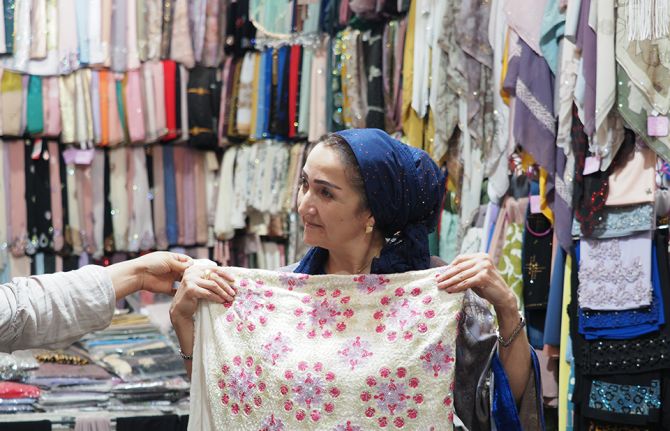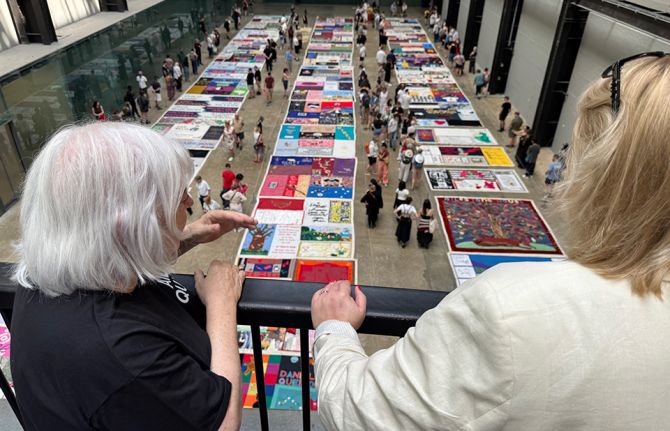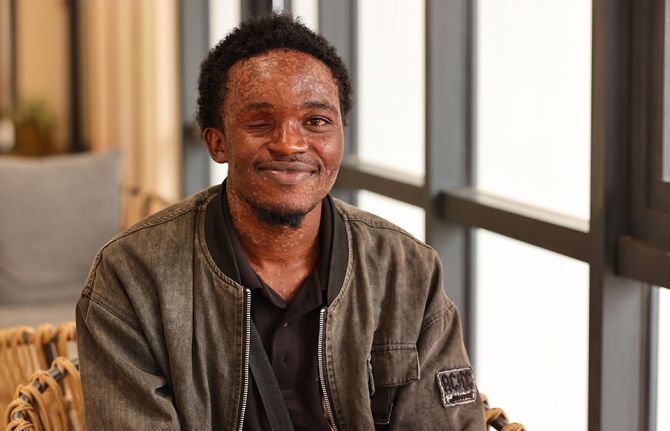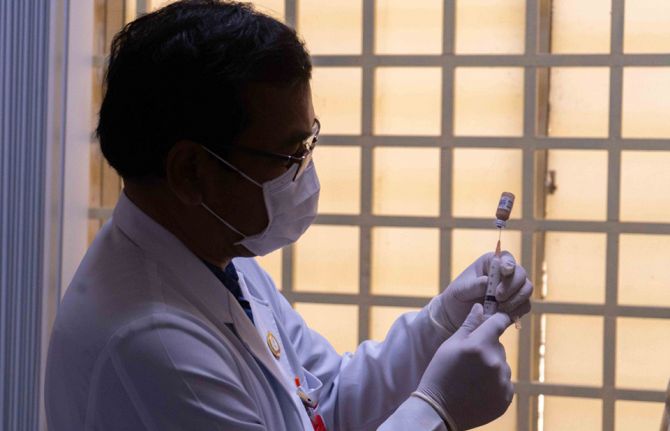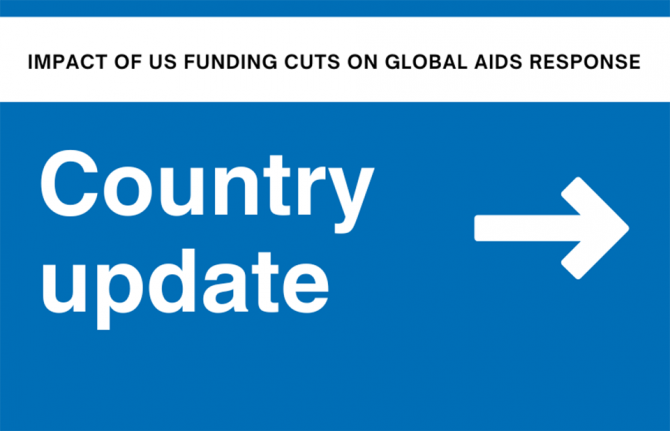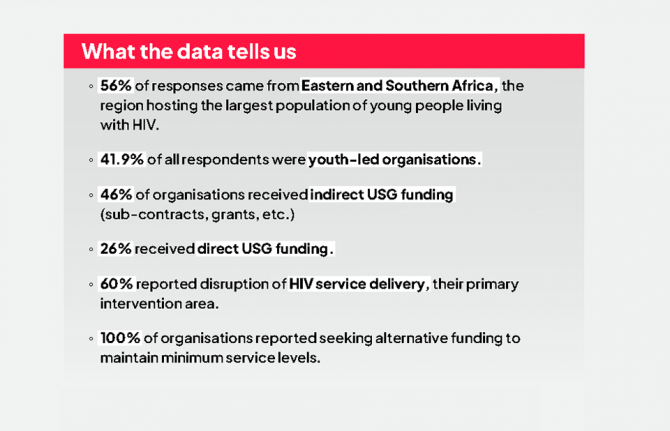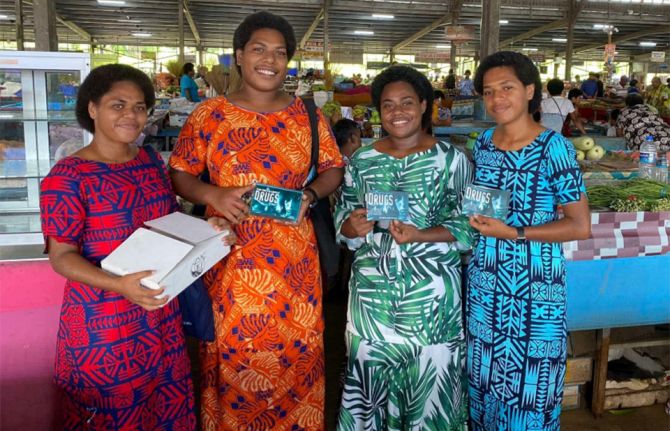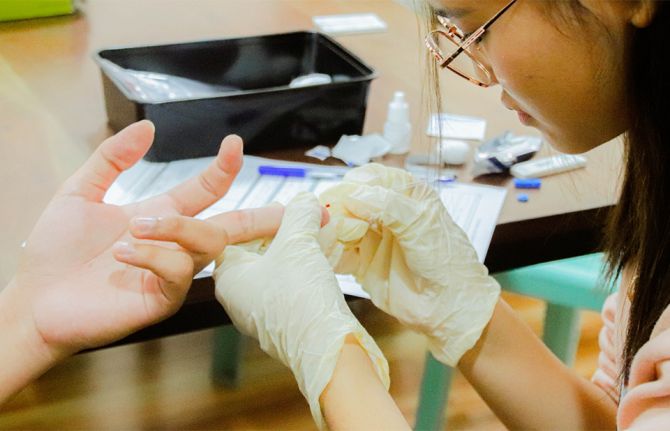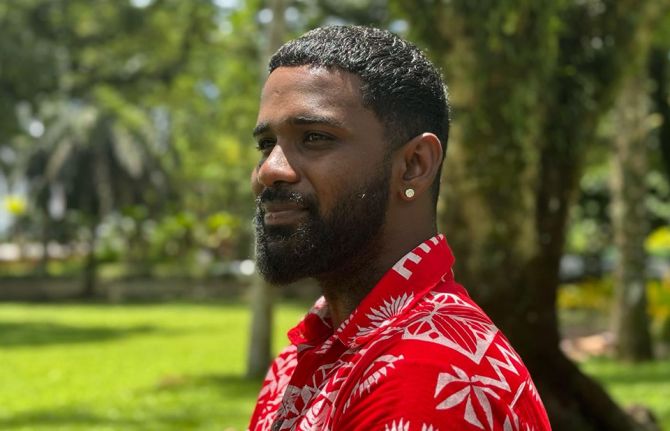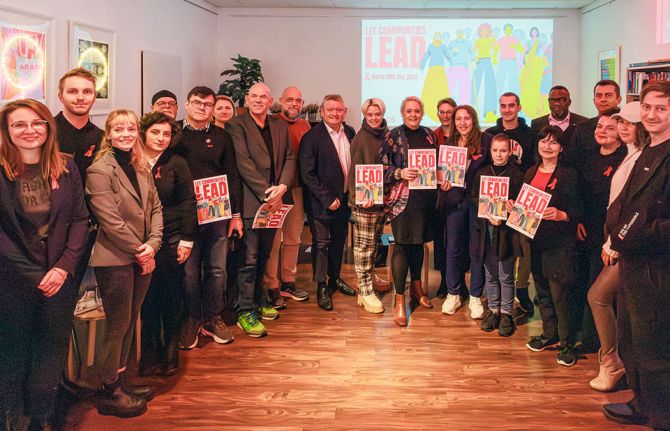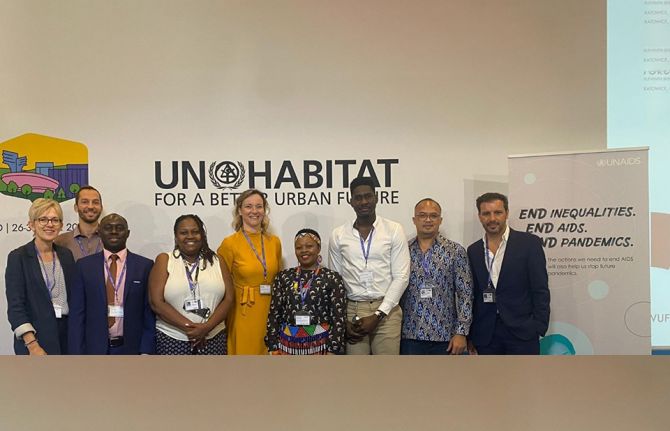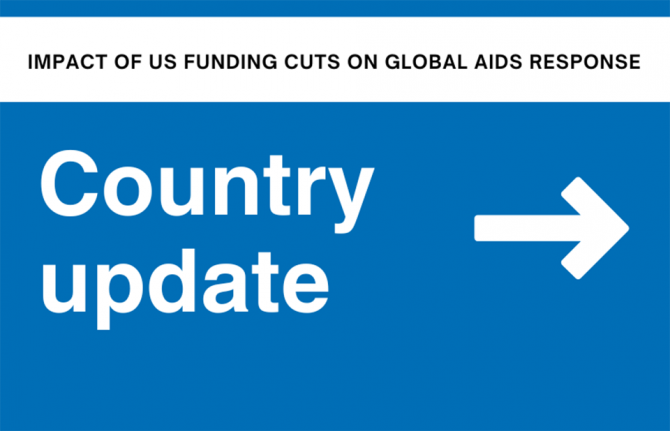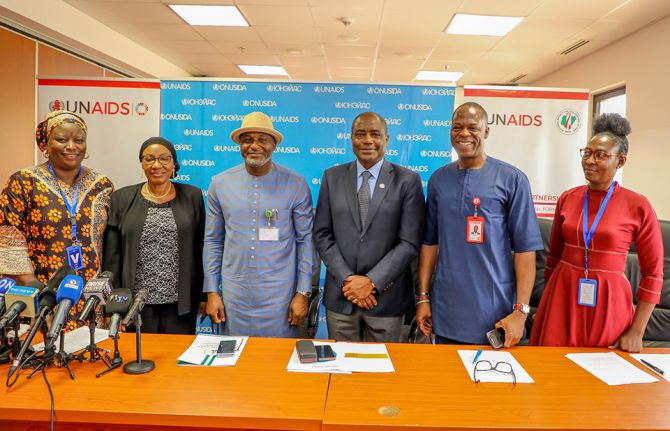
Feature Story
Positive response to AIDS in Ukraine
17 September 2007
17 September 2007 17 September 2007Experience and evidence show that for an effective response to AIDS, it is essential to involve people living with HIV at all levels. Networks of people living with HIV are uniquely well qualified to help unify the response and maximize efforts to reach out to communities as well as influence national policy.
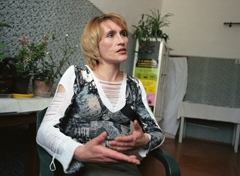
UNAIDS has produced a new report that describes
the background, structure and operation of the All-Ukrainian Network of People Living with HIV, as an example of best practice within the AIDS response.
In order to promote and help replicate the work of associations of people living with HIV, UNAIDS has produced a new report that describes the background, structure and operation of the All-Ukrainian Network of People Living with HIV, as an example of best practice within the AIDS response.
“The All-Ukrainian Network of People Living with HIV has an innovative structure, has undertaken high profile successful advocacy campaigns at both national and local levels and has a strong track record of delivering an ever-expanding array of services to people living with HIV,” the report says. “From the outset, people living with HIV have been responsible for the Network’s very rapid growth and strategic importance in the country’s HIV response.
”Ukraine has the most severe HIV epidemic in Europe, with an estimated 377 600 people living with the virus at the end of 2005. The Network was formed in the late 1990s by people living with HIV alarmed by the rapidly growing HIV epidemic in the country and the lack of resources and support available to them and others living with the virus. Since then, the Network has grown rapidly and steadily from its registration in 2000 to its designation as a co-Principal Recipient of a Global Fund grant to distribute funds for treatment, care and support. In 2006, it provided services and support to more than 14000 people living with HIV.
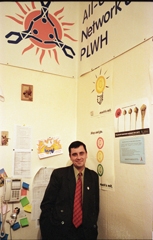
At the national level, the
Network’s advocacy efforts have
resulted in a number of high
profile achievements in recent
years.
The Network was established under four key strategy components: increasing access to non-medical care, treatment and support; lobbying and advocating to protect the rights of people living with HIV; increasing acceptance towards people living with HIV throughout society; and enhancing the organizational capacity of the Network.
Through its local branches and affiliated organizations, the Network provides services to thousands of people living with HIV across Ukraine. It also works with ‘indirect clients’, such as injecting drug users, health-care workers, journalists and law enforcement officials, as part of a broader effort to increase social tolerance, raise awareness about HIV transmission prevention and reduce stigma and discrimination.
More than 20 distinct types of services are offered around the country ranging from transportation and nutrition support to treatment literacy training and child-care facilities. Some local groups may even provide a teacher in instances when real or perceived discrimination keeps HIV-positive children out of public schools.
At the national level, the Network’s advocacy efforts have resulted in a number of high profile achievements in recent years, notably a series of meetings with the Ukrainian President in November 2005, where he committed to take personal control of the government’s response to the epidemic. Furthermore, recent advocacy and awareness-raising efforts at national level include continuing efforts to push the government to increase antiretroviral treatment and HIV testing availability through the public sector; working with the media to publicize issues such as poor service delivery; delays within the Ministry of Health; the high price of antiretroviral drugs; and corruption within the procurement and tendering processes.

Local branches of the Network also initiate smaller-scale advocacy efforts that relate to their local needs.
Local branches of the Network also initiate smaller-scale advocacy efforts that relate to their local needs. For example, one group successfully filed and won a court case defending the rights of HIV-positive parents to maintain custody of their children. In August 2006, another group successfully advocated for the provision of antiretroviral treatment in local prisons. Within two months, five inmates were on treatment and two prisons now also have the capacity to provide CD4 testing.
The Network seeks to form partnerships with as many stakeholders as possible. It currently works with government agencies, international organizations, donor agencies and domestic NGOs. “Although often there are strategic and procedural differences with some of the partners, the Network has refused to break ties even as it lobbies, privately and publicly, for policy change,” the report states.
The Network’s collaboration with international organizations, bilateral donors and civil society groups has consisted of financial support, technical assistance, advocacy collaboration and policy development at local, national and international levels. Although initially the Network was mainly the recipient of the assistance, as it has developed, it has played a growing role in identifying ways to share its expertise and experience.
Underlining the Network’s importance as an example of best practice, UNAIDS Partnerships Advisor Kate Thomson said: “This is a role model for positive networks the world over and provides us with a truly inspiring example of positive people coming together to make a difference in the AIDS response.”
Links:
Download the Best Practice - A Nongovernmental Organization’s National Response to HIV: the Work of the All-Ukrainian Network of People Living with HIV
Read more on Ukraine
Other UNAIDS Best Practice reviews:
Learning from experience
A faith-based response to HIV in Southern Africa
Traditional healers join the AIDS response
Focused AIDS programmes in Asia and the Pacific
Injecting drug use: focused HIV prevention works

Feature Story
Promoting sport and HIV prevention
12 September 2007
12 September 2007 12 September 2007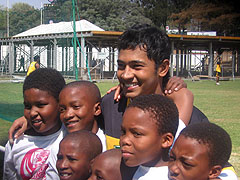
The group of 9- and 10-year-old ‘mini-cricketers’ from
Alexander Township on the outskirts of Johannesburg,
were at Wanderers to meet some of their heroes from
the Bangladeshi cricket team.
“What do you want to do when you grow up?” “Play cricket for South Africa!” the six boys cried out in unison when asked about their future aspirations.
The group of 9- and 10-year-old ‘mini-cricketers’ from Alexander Township on the outskirts of Johannesburg, were at Wanderers to meet some of their heroes from the Bangladeshi cricket team, here to participate in the ICC World Twenty20 2007, taking place in South Africa from 11 to 24 September.
The youngsters are all involved in the sports programme of loveLife – South Africa’s national HIV prevention programme for young people. The programme aims to introduce sport and develop interest and skills of underprivileged children who may not otherwise have the opportunity to play organized sport and instead turn to ‘risky’ behaviours that make them vulnerable to HIV infection. As in all loveLife programmes, HIV prevention messages are integrated into the sporting activities.
“LoveLife focuses on the next generation of South Africans”, said Rudy Van Rensburg, the organization’s outreach coordinator. “Some 95 percent of 15-year-olds in South Africa are HIV-negative currently and it is our responsibility to keep them free of the virus. All of our programmes teach positive living, whether through sport or self-development, motivating them to reach their future potential.
”LoveLife, together with the ICC, UNAIDS, UNICEF and the Kaiser Family Foundation, have joined together in a unique partnership to highlight the situation of children and young people living with and affected by HIV through the global game of cricket.
The Bangladeshi cricket team is the youngest in the international test-playing league, with an average age of only 22. Yet, they have scored a number of impressive successes on the field – most notably the landslide win over top team South Africa at the World Cup 2007. Many put this down to the young age and fearlessness of the players.
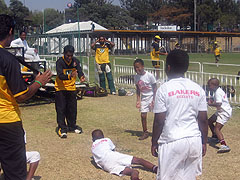
The Bangladeshi cricket team is the youngest in the
international test-playing league, with an average
age of only 22. Yet, they have scored a number of
impressive successes on the field – most notably the
landslide win over top team South Africa at the
World Cup 2007.
“Yes, we are young and maybe fearless because of that,” said 19-year-old wicket keeper Mushfiqur Rahim. “But we’re also very professional and mature when we’re out on the pitch. We are very aware that have a responsibility to each other as teammates and to the nation to do our best.
”This sense of responsibility and leadership are lessons that they, as international cricket players and role models to millions of young people around the world, are keen to pass on to the next generation of ‘mini-cricketers’. They are also qualities fundamental to HIV prevention.
Although Bangladesh has a low HIV prevalence rate compared with other cricket-playing countries, the players are aware that effective HIV prevention is key to keeping the number down and it is particularly important to target children and young people to ensure an AIDS-free generation.
“Young cricket fans look up to us and we have a role to play in teaching them about HIV prevention and how to protect themselves from infection,” added Mashrafe Mortaza, at 24 the veteran of the team. A fast bowler, Mortaza was the world’s top wicket taker in ODIs in 2006. “We are young but take our responsibilities seriously and do what we can to support the HIV and young people awareness-raising campaign of the ICC”. When in India for the World Champion’s Trophy tournament earlier this year, some of the Bangladeshi cricketers filmed HIV prevention public service announcements, as they are doing again here in Johannesburg to be broadcast during the televised Twenty20 matches.

A number of top players from all 12 teams participating
in the international tournament will feature in public
services announcements for the ‘Unite for Children.
A number of top players from all 12 teams participating in the international tournament will feature in public services announcements for the ‘Unite for Children. Unite against AIDS’ global campaign bringing attention to the ways in which HIV is affecting the lives of children and young people everywhere.
Coming off the pitch, the Bangladeshi players stopped to greet the youngsters, asked about their bowling and batting skills, and happily posed for group photos with the excited boys. A few then joined in an impromptu game of catch, testing the professed skills of these future cricket stars.
The normally chatty Molefe Makubela, one of the six lucky boys, was almost without words following this close encounter with the cricket stars. All he could say, over and over again, was “It was very nice, it was very nice’ - a big grin on his freckled face.
Links:
Read more on the ICC Twenty20 World Championships
Read more on Unite for Children: Unite against AIDS
Related

Feature Story
McCullum backs HIV and AIDS campaign
12 September 2007
12 September 2007 12 September 2007Neil McCullum wears two caps – star cricketer for Scotland on the pitch as well as a physical education teacher.
Squeezing in training sessions and international cricket play when his day job allows, Neil also manages to make time in his busy schedule to support the ICC’s HIV awareness programme by visiting children infected with or affected by the illness.
In Nairobi earlier this year to face for the ICC World Cricket League, Neil together with a number of his team mates paid a visit to a local school for children living with HIV to coach a chosen few in the art of cricket.
The visit was part of the ICC’s partnership with UNAIDS and UNICEF to raise awareness and reduce stigma around HIV and the impact of AIDS on children and young people through the global campaign ‘Unite for children, United against AIDS’.
“We started with a group of six,” related Neil. “But soon more and more children joined in until the entire student body of 60 boys and girls surrounded us, clamouring for our help with their bowling and batting technique!”
Smiling at the memory of the visit, Neil then became thoughtful. “My visit that day was a massive eye-opener to the situation of these children,’ he said. “I was touched by their positive spirit and terrific enthusiasm.” He added: “It was a very moving experience and will remain a lasting memory.”
When he returns to his own students in Scotland, Neil makes a point of sharing his experiences with them to increase their awareness of HIV and to help reduce the stigma often associated with AIDS.
“It is important that young people at home are aware of the disease and of the situation of young people in other parts of the world who may be less fortunate,” explained Neil. “It is important that we come together around this issue and tackle it as a global community. The world must unite against AIDS.”
In South Africa to play in the inaugural ICC World Twenty20 2007, being held from 11 to 24 September, Neil, his teammates and all players of the 12 competing teams will be wearing red ribbons to show their support for children and young people infected with or affected by HIV in nine games of the tournament, including the final, to be televised around the world: ‘Uniting the world against HIV and AIDS.
Links:
Read more on the ICC Twenty20 World Championships
Read more on Unite for Children: Unite against AIDS
Related

Feature Story
“Cricket can help combat HIV and AIDS”, says Graeme Smith
12 September 2007
12 September 2007 12 September 2007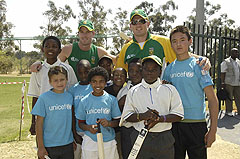
The Proteas skipper Graeme Smith is optimistic about
how cricket can add to combating HIV among children
and young people.
Talking tough to the opponents, Smith, who joins an array of leading cricket icons to aid the “Unite for Children, Unite Against AIDS” global campaign, couldn’t ignore the attention he was getting from scores of children and young admirers during a training session at Johannesburg’s Wanderers Stadium.
“HIV and AIDS are relevant and pressing subjects here in South Africa. As cricketers we command the attention of the public and the media, and we want to use that to try and better the situation for the children and young people,” he said.
He added: “We have an important role to ensure that the message that says children’s rights and needs take prominence in the fight against AIDS reaches all the relevant people.
”Fielding coach Jonty Rhodes joined the skipper in a short coaching clinic for the children. The smiles on the children and how they treasured the autographed miniature bats by the cricket stars left an impression that cricket has touched them in more ways than one.
The “Unite for Children, Unite Against AIDS” campaign stresses the unacceptable levels of HIV prevalence among children and young people. It also makes a call to action to de-stigmatize the AIDS epidemic and shows how the values of cricket are applicable responses to AIDS while giving greater visibility to children living with and affected by AIDS.
The campaign recognizes the power of world class cricket as a platform to raise awareness of HIV and AIDS, especially among children and young people. The ICC World Twenty20 2007, taking place in South Africa in September, is expected to add impetus to the campaign.
The South African cricketers have also recorded video footage, amplifying key messages overarching the “Unite for Children, Unite Against AIDS” campaign as part of the ongoing awareness programme.
The backdrop to the campaign is the staggering numbers of than 1000 children under 15 dying from AIDS-related diseases every 24 hours. So, far more than 15 million children have lost one or both parents to AIDS.
Links:
Read more on the ICC Twenty20 World Championships
Read more on Unite for Children: Unite against AIDS
Related

Feature Story
Aussie stars support loveLife project
12 September 2007
12 September 2007 12 September 2007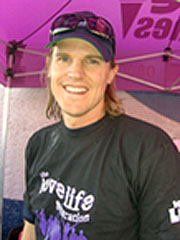
Nathan Bracken said: "By visiting projects
to raise AIDS awareness, hopefully we
can play a role in the ICC's partnership
with UNAIDS and UNICEF to reduce
stigma around HIV.
Nathan Bracken and Brad Hodge took time out of their preparations for the ICC World Twenty20 2007 to visit a project as part of the ICC’s work with UNAIDS and UNICEF to raise awareness on AIDS.
They visited the loveLife Orange Farm Y-Centre, part of South Africa's national HIV prevention program for youth, to meet young people who both volunteer and attend the project.
Nathan Bracken said: "By visiting projects to raise AIDS awareness, hopefully we can play a role in the ICC's partnership with UNAIDS and UNICEF to reduce stigma around HIV. It is important that projects like loveLife provide opportunities for young people to make informed choices about the way they live their lives and help halt the spread of HIV.
"loveLife Y Centres provide hubs for regional networks of franchise holders, adolescent friendly clinics and outreach programs. They serve as best-practice sites for youth leadership development and adolescent clinical services; training venues for groundBREAKER and loveLifestyle programs; and provide trained facilitators to support the loveLife Games and other outreach programs.
Brad Hodge: "Sport is a great way of inspiring young people and teaching them skills which they can use in all areas of their life. It has been very moving to see how loveLife provides opportunities for young people to develop their confidence by taking part in a range of team sports."
Links:
Read more on the ICC Twenty20 World Championships
Read more on Unite for Children: Unite against AIDS
Related

Feature Story
AIDS: everybody’s business
12 September 2007
12 September 2007 12 September 2007
Finding innovative solutions to key health challenges to ensure the long-term economic development of nations worldwide was the focus for business leaders attending the three-day meeting of New Champions. The meeting took place in Dalian in the People’s Republic of China from 6 to 8 September 2007.
The issue of AIDS took a particularly prominent position with a symposium dedicated to how business could contribute to responding to the epidemic. The symposium gathered high-level representatives from government, business, NGOs and international organizations—including UNAIDS Executive Director Peter Piot—to discuss the issue of AIDS in the workplace.
Christine Ockrent, author and Editor-in-Chief of the French television channel France 3,introduced the discussion noting how big business had been slow to realize the staggering impactl of the AIDS pandemic. “AIDS, she said, has become the fourth cause of death in the world and may soon be the third. Eight thousand people die each day from AIDS,” she added.
What role can new business champions play?
As part of his intervention, the UNAIDS Executive Director presented three comparative advantages of the business sector in addressing the epidemic. First of all, he underlined, business has expertise in long-term strategic planning, risk assessment, research, development and marketing. Private companies can also, reach out to millions of people, who would otherwise be out of reach, through HIV in the workplace programmes and workplace programmes also allow proper follow of the beneficiaries. Additionally, he stressed, the business sector has an outreach potential far beyond its own sector and plays a real leadership role in today’s world.
Other speakers at the symposium included Bo Shao, Chairman, Novamed Pharmaceuticals in the People's Republic of China; Raenette Taljaard, Executive Director of Helen Suzman Foundation in South Africa; Sir Martin Sorrell, Group Chief Executive of WPP Plc in the United Kingdom; and Rajat Gupta, Senior Partner of McKinsey & Co. and Chairman of the Board of The Global Fund to Fight AIDS, Tuberculosis and Malaria.
Mr Gupta noted that the case for business was grounded in completely enlightened self-interest. "We need a healthy workforce,” he said.
WPP’s Sir Martin Sorrell added that HIV must be recognized as one of the world’s two global priorities, along with climate change. He cited ignorance and discrimination as major obstacles in the response to AIDS. “Obstacles, he noted, that can be overcome through better education and where New Champions can contribute by using existing services and by inventing new service delivery tools.
”While the business sector offers some examples of innovative partnerships in response to AIDS, most of them are to be found in large multinational companies. Adidas for example has partnered with Marie Stopes International to provide reproductive health and AIDS prevention education to the young, female migrant workers in their supplier factories. But many more such initiatives are needed across the sector.
“Business has a vital role to play in the response to AIDS. The multi-sectoral nature of AIDS presents enormous opportunities for further contributions from business, in its resources, expertise and long-term planning,” said Regina Castillo, UNAIDS' Team Leader of Corporate and Private Sector Partnerships.
Links:
Read WEF press release
Visit the World Economic Forum's web site for more information on the Dalian meeting

Feature Story
Pakistan cricket team talks about HIV prevention
11 September 2007
11 September 2007 11 September 2007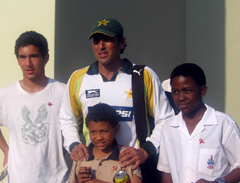
Bats flashing. Balls flying. The three young boys, their fingers intertwined in the links
of the wire-mesh fence, watched mesmerized as some of their cricket idols trained on a pitch just outside of Johannesburg in South Africa.
The Pakistan cricket team had invited the youngsters from loveLife – the national HIV prevention programme for young people in South Africa – to their training session in support of the International Cricket Council’s partnership with UNAIDS and UNICEF to bring attention to the situation of children and young people living with or affected by HIV.
The Pakistan cricket team is among 12 world teams currently gathered in South Africa to play in the inaugural ICC World Twenty20 2007, which is being held at various locations throughout the country from 11 to 24 September.
Coming off the pitch after their practice session, the cricketers took time to sign commemorative bats, take photos – and talk to the young boys about the importance of HIV prevention.
“Be safe. Be strong. Love life!” said Shoaib Akhtar, arguably the fastest cricket bowler in the world and a clear favourite of the young fans.
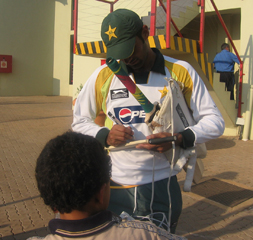
“AIDS is a challenge for all countries in the world, and especially for cricket-playing countries, which are among the most affected by HIV,” added Kamran Akmal. As the AIDS Ambassador for the Pakistani team, Kamran devotes much of his time to HIV-related activities in his home country, spreading the ‘Play safe’ message. “It must be our common goal to defeat HIV.”
Some 40 million people in the world are infected with HIV – nearly 15 million of them living in cricket-playing countries.
Pakistani captain Shoaib Malik was the first player to arrive for the training session and the last to leave – a reflection of his responsibility as team leader. “Being the captain of the team is a difficult job. It means giving 110 percent. But strong leadership is important to the performance of any team. It is also important that we show leadership as role models for young people through the world and we are proud to be part of the ICC partnership with UNAIDS and UNICEF.”
Pakistan stars and other top players, including South African captain Graeme Smith, Kuman Sangakkara of Sri Lanka and India’s Yuvraj Singh will feature in public service announcements for the ‘Unite for Children, United against AIDS’ global campaign highlighting how HIV impacts on the lives of young people. These will be made available to broadcasters in 105 countries across the world as well as being watched by fans on the big screens at the 27 matches during the tournament.
Links:
Read more on the ICC Twenty20 World Championships
Read more on Unite for Children: Unite against AIDS

Feature Story
AIDS focus at ICC South Africa cricket championship
10 September 2007
10 September 2007 10 September 2007Aussie stars support loveLife project
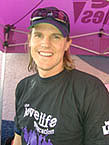
Nathan Bracken and Brad Hodge took time out of their preparations for the ICC World Twenty20 2007 to visit a project as part of the ICC’s work with UNAIDS and UNICEF to raise awareness on AIDS.
“Cricket can help combat HIV and AIDS”, says Graeme Smith

The Proteas skipper Graeme Smith is not only upbeat about victory in the ICC 2007 World Twenty20 but also optimistic about how cricket can add to combating HIV among children and young people.
Promoting sport and HIV prevention

“What do you want to do when you grow up?” “Play cricket for South Africa!” the six boys cried out in unison when asked about their future aspirations. The group of 9- and 10-year-old ‘mini-cricketers’ from Alexander Township on the outskirts of Johannesburg, were at Wanderers to meet some of their heroes from the Bangladeshi cricket team, here to participate in the ICC World Twenty20 2007, taking place in South Africa from 11 to 24 September.
McCullum backs HIV and AIDS campaign
Neil McCullum wears two caps – star cricketer for Scotland on the pitch as well as a physical education teacher.
Squeezing in training sessions and international cricket play when his day job allows, Neil also manages to make time in his busy schedule to support the ICC’s HIV awareness programme by visiting children infected with or affected by HIV.
Pakistan cricket team talks about HIV prevention
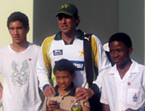
Bats flashing. Balls flying. The three young boys, their fingers intertwined in the links of the wire-mesh fence, watched mesmerized as some of their cricket idols trained on a pitch just outside of South Africa.
Cricket chief and star show AIDS solidarity in India
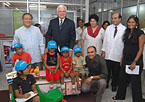
Head of the International Cricket Council (ICC), Malcolm Speed joined Indian star Virender Sehwag and Cecilio Adorna, UNICEF India country representative, in a visit to the Antiretroviral treatment centre of the Kalawati Saran Children’s Hospital in New Delhi at the end of August. The visit was part of the ICC's partnership with UNAIDS and UNICEF to raise awareness and reduce stigma around AIDS and the impact of AIDS on children through the global campaign, UNITE FOR CHILDREN UNITE AGAINST AIDS.

Stars back AIDS awareness campaign at ICC World Twenty20 in South Africa
International cricketers will highlight the situation of children and young people living with HIV as part of a far-reaching AIDS awareness campaign during the 2007 World Twenty20 world cricket championship in South Africa.
AIDS focus at ICC South Africa cricket championsh
Related

Feature Story
International Health Partnership launch
05 September 2007
05 September 2007 05 September 2007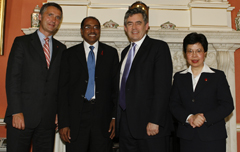 From left to right: Norwegian Prime Minister
From left to right: Norwegian Prime Minister Jens Stoltenberg, UNAIDS Deputy Executive
Director Michel Sidibe, British Prime Minister
Gordon Brown, and Dr Margaret Chan, Director-
General of the World Health Organization
(Photo: Richard Lewis/Crown Copyright)
Leaders from donor countries, funding organizations, developing nations, and international agencies came together in London on Wednesday 5 September to launch a new international partnership to help improve healthcare systems in the developing world.
Led by the government of the United Kingdom, the International Health Partnership was launched formally by UK Prime Minister Gordon Brown at an event at 10 Downing Street, London.
The initiative aims to increase donor, country and international coordination on health and development issues in order to drive forward work on the health-related Millennium Development Goals (MDGs) – reducing child mortality, improving maternal health, and halting and reversing the spread of HIV.
Following a roundtable discussion focusing on implementation, participants signed a compact to work within countries’ national plans and improve coordination in order to address problems related to health worker staffing, infrastructure, health commodities, logistics, tracking progress, and effective financing. Partners will work together to ensure that health plans are well-designed, well-supported and well-implemented and to make their work more effective and better aligned with developing countries’ established priorities.
In a statement released on Wednesday 5 by the United Kingdom, Prime Minister Gordon Brown said, “There is no greater cause than that every man, woman and child in the world should be able to benefit from the best medicine and healthcare. Today we come together – donor governments, health agencies and developing countries – with the certainty that we have the knowledge and the power to save millions of lives through our efforts.”
In an initial phase, seven ‘first wave’ countries – Burundi, Cambodia, Ethiopia, Kenya, Mozambique, Nepal and Zambia – have joined the partnership and participated in the London event. Also attending were Heads of State and ministers from donor countries such as Norway and Canada and senior figures from international agencies, including UNAIDS. Philanthropist Bill Gates attended on behalf of the Bill and Melinda Gates Foundation.
Speaking at the event, UNAIDS Deputy Executive Director Michel Sidibe underlined the importance of the partnership. “To improve global health, it is critical that we have better coordination and mutual accountability from all parties: countries, donors, and the international organizations.” he said. “The International Health Partnership will be crucial in order to deliver on our commitments to the targets of Universal Access to HIV prevention, treatment, care, and support, and in reaching all the health-related Millennium Development Goals. The global response to AIDS has shown us that increased coordination can lead to progress. We also need to stay focused on the concrete results that we are all committed to, at the same time putting in place predictable, scaled-up financing for a long-term sustainable response.”
A joint statement from international health partners – UNAIDS, The GAVI Alliance, Global Fund to Fight Aids, Tuberculosis and Malaria, UNICEF, United Nations Population Fund, World Bank and the World Health Organization – welcomed the initiative: “We, as international health partners committed to improving health and development outcomes in the world, welcome and fully support the International Health Partnership's mission to strengthen health systems, and we congratulate those involved for setting it in motion.”
“We will be coordinated and accountable in this work and take every opportunity to capture knowledge and lessons learned in improving health programmes,” the partners stated.
The International Health Partnership is the first of several complementary initiatives being launched by donor countries over the next several weeks as part of a new Global Campaign for the Health Millennium Development Goals. More information will be featured in the coming weeks on the UNAIDS website.
Links:
Read the joint statement by international health partnersRead the UK press release
More on the International Health Partnership
Related

Feature Story
Faith leaders join in Nigeria on AIDS
04 September 2007
04 September 2007 04 September 2007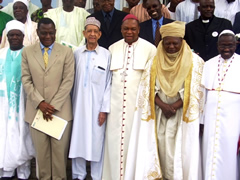
Relegious and government leaders at the opening
ceremony of the Forum.
Photo credits: UNAIDS/S. Aghaeze
Over 150 leaders from all denominations of Christian and Islamic faith communities came together in Abuja, Nigeria to take stock of faith-based organizations’ achievements and good practices within the AIDS response in the country and to examine challenges faced for the future. Hosted by the National Faith-Based Advisory Committee on AIDS – NFACA, the Forum was opened by the highest Muslim and Christian leaders in the country, the Sultan of Sokoto, Alhaji Muhammadu Saad Abubarkar III, represented by Dr Lateef Adegbite, Secretary-General of the Nigeria Supreme Council for Islamic Affairs and Most Reverend Dr John Onaiyekan, President of the Christian Association of Nigeria.
“I want the Christian and Muslim communities in this Forum to come up with a stronger position on HIV prevention, to do more for people infected and affected, and to be more involved in the campaign against stigma and discrimination,” Dr Adegbite said in his opening address.
Most Reverend Onaiyekan pleaded for more recognition and a commensurate allocation of resources to the faith-based AIDS programmes. “There is growing acknowledgement and appreciation– including among the United Nations agencies – of the tremendous role being played by religious institutions and organizations, especially in the poorer countries of the world. However, put bluntly, the money is not going to those who are doing most of the work. It is hoped that this anomaly will be redressed in good time,” he stated.
The bi-annual Forum is the third to have taken place in Nigeria to strengthen the faith-based response to AIDS in the country. The forums provided unique avenues for the Christian and Islamic faiths to interact and to strategize on their role in the national AIDS response.
At the 2007 Forum, the participants made recommendations on the way forward and on policy and strategic issues relating to HIV prevention, testing, care and support, and gender in the Forum’s communiqué. They agreed that faith-based organizations should identify their areas of competence and do more of what they do best, including HIV prevention, promoting and providing services and caring for people living with HIV. The religious leaders and scholars called for the Nigerian government to accelerate access to free medical treatment and care for all people living with HIV who need it.
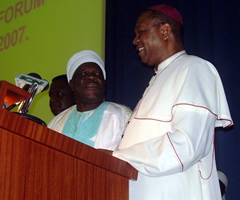
Most Reverend J. Onaiyekan and Dr Lateef Adegbite
declaring the Forum opened.
Photo credit: UNAIDS/S. Aghaeze
On the issue of HIV testing and counseling, the faith leaders committed to mobilizing their communities to access services on a voluntary and confidential basis as they had been exhorted to by Professor Babatunde Osotimehin, Director-General of the National Agency for the Control of AIDS, in his update on the status of the national response: “HIV generates harmony among faith communities. We expect this Forum to make a strong statement on how to mobilize communities to access voluntary and confidential HIV counseling and testing. Compulsory testing should not be in your vocabulary,” he said.
The Forum was organized by the National Agency for the Control of AIDS and supported by UNFPA and UNAIDS.
UNAIDS Country Coordinator Warren Naamara gave a goodwill message to participants of the Forum, underlining the importance of religious leader’s engagement in the AIDS response. “Your influence on opinions, policies, practices and attitudes reaches from the grassroots and remote communities to the very top level of government and decision-makers. Your compassion and support has always embraced the disenchanted and the vulnerable, the sick, the children and the weak in need of assistance,” he said. “Your speaking out against stigma and discrimination, against rejection and marginalization of people living with HIV, will make a world of difference to the everyday life of people infected, within and beyond their religious communities,” he added.
Links:
Read the opening address by Most Rev. John Onaiyekan, President of the Christian
Association of Nigeria
Read the goodwill message by Dr. Warren Naamara, UNAIDS Country Coordinator
Read the Forum Communiqué


